Trip to Germany Part 4
"Ancient Rothenburg"
(ob der Tauber)by Ron Kitson
It seems that every big tourist attraction or area we visited in this part of Europe had something to offer that was at least overwhelming. You'd tell yourself "this is the best so far" and you'd wonder, how can it possibly get better than this, but it does. It's not that another castle or cathedral is bigger, older or more lavish, they are all different from one another and incredible in their own unique history and design.
Back in the days when these ancient structures were built, the guy with the lunch pail worked very hard and most of what he earned was taken in taxes to fund these elaborate houses for those few who lived in luxury. Things were a lot different than they are today. Well, not totally different but folks get to vote now and that makes a big difference. There was a time here when this was part of the Roman Empire and only the Roman Catholic Church could own property and collect taxes and of course, they made and enforced all the rules. Nothing was too big or too expensive and needed to surpass all others to date.
Then came the era of Royal Highnesses who also lived well above the soil. Many of their projects took well over a hundred years to build so those who built the bottoms, never got to see the tops.
Many of these have been devastated by wars over the centuries but in most cases have been restored to their original wonder and tourists from around the world come to witness.
In Rothenburg by the Tauber River, you walk the same narrow cobblestone streets as did emperors, kings, queens, and famous military leaders for more than a thousand years. Sweedish King Gustav-Adolf stayed here in 1632 living in the town hall or Rathaus which is in two sections. The old section with a high white facade and bell tower was built in 1250 but was partially destroyed by fire in 1501. The white section with the tower survived however and is part of the existing structure. 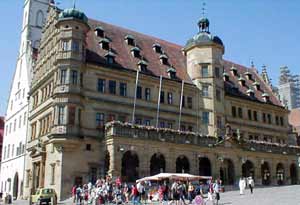
The Rathaus (City Hall) on the
market square in Rotenburg
The new Rathaus was constructed from 1572 to 1578 and the Baroque arcade was added in 1681. Y'know, it makes it a bit hard to get excited over our "Century Homes" but they too are well worth preserving.
By the way, a Rathaus, pronounced "rot house" is a town or city hall and has nothing to do with rats. "Rat" translates to "counsel" or "advice" and "haus" is "house." As with our own city halls, I am not saying there are no rats in there, I just wanted you to know how a Rathaus got its name.
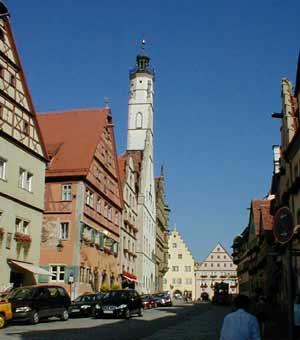
A view up Herrngasse toward the Rathaus on the left and ending at the square.
Adjacent to the Rathaus and also on the square, is the Ratsherrntrinkstube. Let's say it together...Rats-herrn-trink-stube or, Council-men-drink-chambers. Built in 1446, it was originally accessible only by members of the city council.
The ground floor is now occupied by the Rothenburg Tourist Information Office.
The gable facing the market place is home to an "art clock" from 1910, a large city clock from 1610 and at the top just above the city's coat of arms is a sundial placed there in 1768. That's a 24 hour clock in the middle.
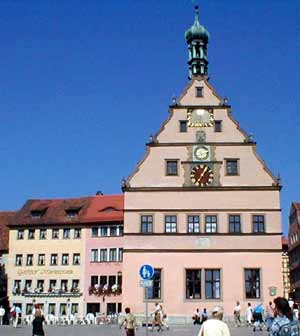
The Ratsherrntrinkstube or Council Tavern.
First settled in the year 970 the East Franconian Earl Reinger sets up a parish in the area and then built the Comburg Castle above the River Tauber. By 1108 Earl Reinger's family circle dies out with Earl Heinrich bequeathing his earthly belongings to the monestary at Comburg, a deal that was nixed by one Emperor Heinrich V who decided to give Rothenburg to his nephew. (A lot can be said for having a rich uncle like Uncle Heinrich) In 1137 Konrad III becomes King of Germany and holds court in Rothenburg.
In 1172 Rothenburg is granted a town charter and the first town wall plus some towers are built. Soon, people in the suburbs started to get nervous and wanted to move inside and by 1204 they started phase two and added another 1,000 meters to the wall, most of which is still preserved.
(Note: Cities obviously had more appeal back then)
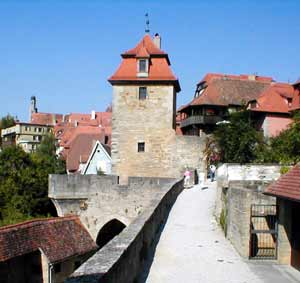
A section of the old wall and the
Kobolzell Gate Tower.
In the 14th century, Rothenburg annexed adjacent Spital and a second extension was added increasing the length of the wall to 3,400 meters. That's 3.4km or, 2 miles, 220 yards or, 3,740 yards if I did the math right. (Metric is easier)
They must have been pretty good craftsmen because eight hundred years later we walked up ancient steps and along the top of that first section of wall and my guess is that 800 years from now, it will still look pretty much the same. In fact, if I were a betting man, I'd put money on it.
In 1618 the 30 year war begins and the City of Rothenburg is forced to not only contribute financially, but to accommodate troops passing through who were not always polite house guests.
Over the next several centurys, Rothenbug would see not only frequent change of ownership, but much bloodshed and war damage with the most recent being a bombing raid in March of 1945. However, after the war, financial support from the rest of Germany as well as from abroad, allows for complete reconstruction of the city and its walls. As is the custom in Germany, when old structures get damaged, they rebuild them using the same materials where possible and to the original design.
Guided tours are the best way to see Rothenburg but you need more than one day to see it. They do offer tours lasting up to 7 days and you can contact the Rothenburg Office of Tourism at www.rothenburg.de (Click on the Union Jack for English)
Next stop, Neustadt which means "new town." It's a very old city but like very old songs, cars and people, it had a beginning. Neustadt lies between Speyer and Kaiserslautern. We didn't really visit Neustadt as I would like to another time, but we did see quite a bit of it as we drove through to nearby Hambach Castle. As with so many towns and cities here, Neustadt has a long and colorful history and plenty of tourist attractions.
Before we go any further, let me point out that there are, I believe, eleven Neustadts in Germany, so just asking "is Neustadt near here" would be like calling the Hoffbräu Haus during Oktoberfest and asking "is Hans there?" You need the whole name. This Neustadt on the edge of the Palatinate Forest is called "Neustadt an der Weinstrasse" and is deeply embedded in the heart of wine country. Looking down from Hambach Castle, one sees Neustadt, a number of other smaller communities and, as far as the eye can see, are over 5,000 acres of vineyards. Do they like their wines here, of course they do. 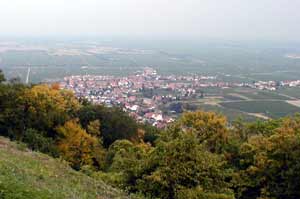
Neustadt an der Weinstrasse viewed from below Hambach Castle.
According to their website, Neustadt an der Weinstrasse along with its nine neighboring wine villages claim 56,000 inhabitants, 28,500 of whom reside in the city of Neustadt.
The oldest city records go back to the year 1245 and the foundation stone of their oldest church was laid in 1368. What they consider their most important date in history, the 27th of may, 1832 was when the first demonstration demanding human rights and democracy took place at Hambach Castle. 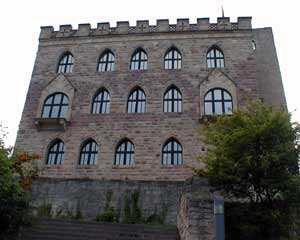
Hambacher Schloss (Hambach Castle)
The first apparent campers here it is said, were Romans who settled on the present site of the castle around 350 AD. The castle was built around 1000 and about 1100, it is taken over by the Prince Bishops of Speyer.
The castle was damaged in 1525 during the Peasant War. Further destruction came at the hands of the French during the Palatine war of succession in 1688. In 1797, the French take possession of Hambach Castle. In 1816, after the Vienna Congress, the castle, along with the Palatinate,becomes Bavarian. In 1842, Bavarian Crown Prince Maximilian receives the castle as a gift from the people of the Palatinate and became known as Maxburg.
Hambach Castle remained pretty much in ruins until after the second world war when the Federal Republic helped out with the reconstruction costs of approximately 12 million marks.
That demonstration on the 27th of May, 1832 led to an annual "Hambacher Fest" drawing freedom loving citizens from all parts of Germany. Hambach Castle is considered the "Cradle of German Democracy." A significant monument and tourist attraction, not to mention an incredible view of the region.
Two excellent websites:
For Neustadt a.d.Weinst
For Hambach Castle
Next, a quick peek at transportation, driving & getting a drivers' license in Germany where you don't drive or learn to drive until you are 18. Plus, a look at their approach to education which is quite different from ours.
More photos from Rothenburg
Top of Page
Back to Travel
Back to Cleveland Germans
Back to Ron Kitson Memories and Stories
| 
